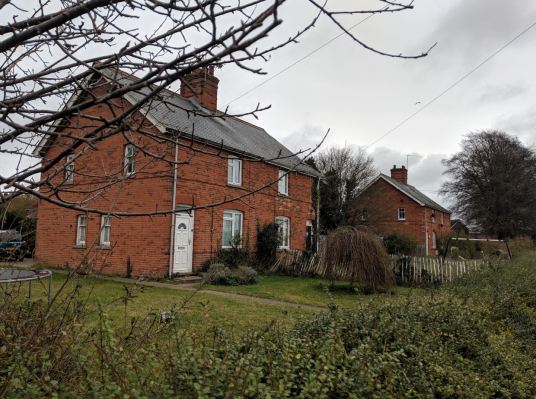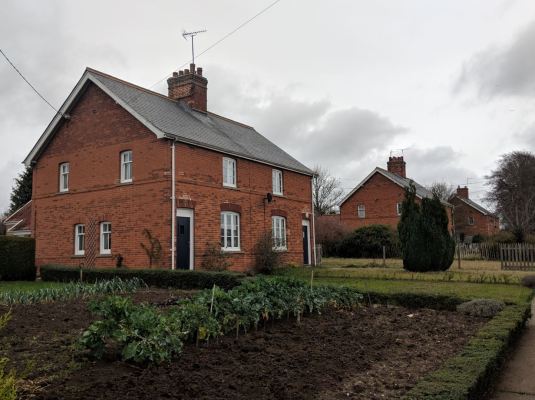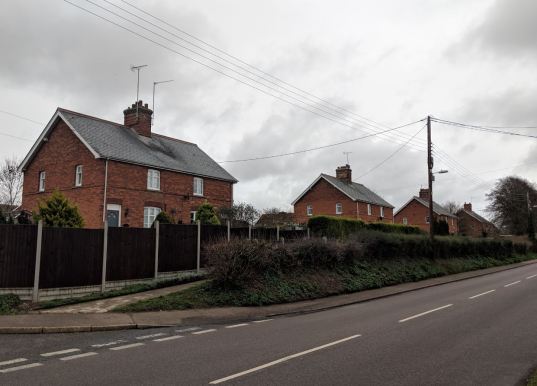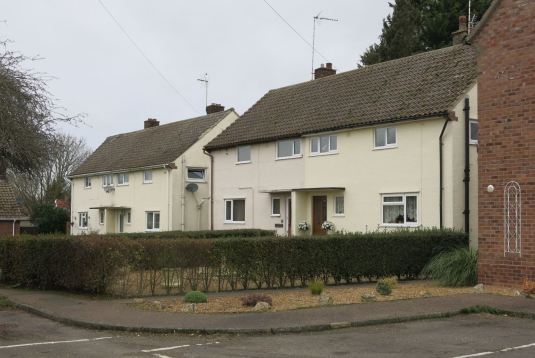They called them ‘Thingoe’s Follies’ – the eight homes built on Stow Road in Ixworth, Suffolk, which formed the first council housing built (in 1894) in the English countryside. And so they were if the attempt to provide decent homes for some of the poorest in England – the agricultural working class of the day – was folly.

Four of the Stow Road council houses
In reality, they are a site of struggle. Depending on your perspective, it’s a story of rural class struggle, pitting an oppressed labouring poor against the entrenched Tory landowning class which ruled village England before the Great War. Or you might see in it an enlightened Toryism – more Downton than Tolpuddle – that remembered traditions of noblesse oblige and adapted the local state to its purpose. Most dramatically, it could be taken to mark the rise of modern Liberalism, a radicalism mobilised by and personified in the unlikely figure of the village’s new vicar, FD Perrott, who believed that his care of souls extended to the tortured bodies of his poor parishioners.

‘A Cottage with Sunflowers’ at Peaslake, Surrey, by Helen Allingham. Undated, probably 1890s, made available through Wikimedia Commons
In telling it, we can begin by forgetting any notions of pastoral idyll we might entertain: (1)
You pass through our quiet villages and you see old cottages covered with honeysuckle, roses, and ivy; you think how beautiful! how restful! But you little imagine what sad decay and misery the outer beauty covers.
British agriculture was suffering an unprecedented depression (largely caused by grain imports from the opening of the American Mid-West) in the last quarter of the nineteenth century. The rural population was falling – fuelling the growth of the cities which has been the main concern of this blog – but conditions for those who remained were often abysmal, as bad as any in the cities. In Ixworth, with a population of about 850 in 1901: (2)
There is a row of houses, the total number of inhabitants is forty-four, and there are three closets for their use. In one house, consisting of two rooms, there are ten in the family… Doors are very bad, and the walls tumbling down. When it rains much, the water runs from the back kitchen into the sitting-room, and forms a pool in the centre.
Such conditions were shocking to Perrott who arrived in the parish in 1888, finding that ‘the Church had scarcely anything to do with the people and the people scarcely anything to do with the Church’.
One of his first acts was to help form – at a time when agricultural trades unionism was a growing though embattled force in the country – the Ixworth Agricultural Labourers’ Association. The Association surveyed local housing needs – both the sorry condition of existing homes and the desperate need for new – and petitioned the local Rural Sanitary Authority (the Thingoe Board of Guardians at this time) to take action under the 1890 Housing of the Working Classes Act.
The Sanitary Authority responded by evicting existing tenants under Part II of the Act addressing unfit accommodation. Perrott and the Association mobilised – ‘meeting after meeting was held’ – to halt these evictions (which would only exacerbate a local housing shortage) and press for action under Part III of the Act, permitting the building of new homes. Reluctantly, the Authority asked the Local Government Board to organise a local inquiry which could compel – if the need for proven – the County Council to grant the permission Thingoe needed to adopt Part III. (This laborious procedure was a major reason for rural authorities’ inaction on housing – and also a fine pretext for it.)

High Street, Ixworth, Suffolk © Andrew Hill and made available through a Creative Commons licence
The Inquiry was chaired by Lord Francis Hervey, the local Conservative MP with – before you leap to conclusions – great care and sympathy. (3) He concluded the case was clearly proven and went further in arguing, against those who railed at the expense to rate-payers: (4)
A certain number of families will be removed from unwholesome lodgings, devoid of proper conveniences, to healthy dwellings with a sufficiency of garden ground; and it is reasonable to suppose that there will not only be less poverty arising from sickness, but that there will be also an addition to the family resources from the sedulous cultivation of the soil, in both cases with results favourable to the ratepayers…Upon economical grounds alone, therefore, the putting in force of Part III of the Act is capable of being justified; but it is impossible to forget that we are in presence of other considerations, social and moral, which, though not susceptible of being gauged by money values, are intrinsically of still higher importance.
There (with just a little archaism) you have the economic and ethical case for council housing – as true now as then – made by a Tory aristocrat.

This contemporary image shows the allotment space to the side of the homes still being put to good use.
Still, the question of finance remained. Hervey had assumed the expense would be borne by the wider district rather than the parish of Ixworth. The Sanitary Authority seized on this alleged unfairness to its ratepayers to secure a second inquiry, ostensibly to tackle the question of funding but in practice used to re-open the entire question.
Perrott’s response was fierce; he attacked the Sanitary Authority: (5)
They were not and had not shown themselves to be guardians of the poor. They had simply been guardians of the rates…They had not treated this case as a poor man’s one but as only as one touching their own pockets… Could there be a body in England so fatuous?
Perrott – by now dubbed the Radical Vicar of Ixworth – also clashed with the local lord of the manor, Captain RN Cartwright, an opponent of the new housing and owner of three quarters of the parish’s 1700 acres and 14 of its run-down cottages. He had earlier attacked Cartwright for evicting an elderly widow in order to house an estate worker. The rhetorical flourish of Perrott’s published address to the Labourers’ Association had a clearly local resonance: (6)
Under the shadow of the luxurious ‘Hall’, at the gate of the tenant-farmer’s comfortable homestead, the labourer (upon whose work both live) drags out a hard life, compelled with wife and children to find shelter and make ‘home’ under a roof beneath which neither squire nor farmer would stable their very cattle.
The inquiry, under Colonel Frederick Pocklington, was convened at 3pm in a deliberate attempt to exclude local workers – though a newspaper report records (after its list of the local great and the good) that ‘a few labourers stood at the back’. (7) It overturned the result of the first inquiry.
At this point, Hervey returned to the field. He secured legal opinion that – as no new evidence had been adduced – Pocklington’s decision was invalid. The verdict of the first inquiry decision stood – the Thingoe Sanitary Authority was compelled to build. Elections to the Authority in 1892 returned a reforming majority and Perrott (as chair) served for one meeting to secure the housing’s final go-ahead.

A contemporary image of the eight council homes on Stow Road
After all that sound and fury, the results might seem disappointing. Eight cottages, designed by Mr F Whitmore, Suffolk County Surveyor, were built on four acres of land at a cost of £1700. They comprised four semi-detached, two-storey houses with a single-storey extension at the rear, housing kitchen, washhouse and lavatory.
With its homes let at £5 5s a year and an additional charge for their large, allotment-style, gardens, financed on a short thirty-year loan, the scheme was not a financial success and the houses proved too expensive for the poorest of the local people for whom they were originally intended.

A side view with a glimpse of the rear extension.
But they were the first fruits of a hard-fought struggle by which the rural working-class would escape a reigning near-feudalism. By 1900, just six rural district councils (the new bodies of local government established in 1894) had adopted part III of the 1890 Act and Thingoe’s eight cottages remained its sole concrete fruits. A 1900 Act, intended to support council housing in the countryside by allowing county councils to build where district councils refused and formally giving parish councils the right to petition for action, had little impact.
Still, Ixworth was a harbinger though, in practice, it would be a new post-war politics that made the difference. The 1936 Housing Act, providing rural councils with a subsidy of up to 80 per cent for the construction of agricultural labourers’ cottages, was crucial. By 1939, 159,000 council houses had been built by England’s rural district councils. (8)
These and their successors were to become a vital component of village life. They are now, sad to say, under unprecedented threat from the Conservative Government’s extension of Right to Buy to Housing Association properties and we’ll need a new generation of middle-class reformers and working-class activists to defend them. (9)
The Reverend Perrott left Thingoe in the year of victory, 1892, and resigned from the priesthood four years later. Re-qualified as a barrister, he remained active for some years as a campaigner for housing reform and, as Frank Duerdin Perrott, the unsuccessful Liberal candidate for the safe Conservative seat of Clapham in the 1900 General Election. He died in 1936, bequeathing funds to support parapsychological research at his alma mater, Trinity College, in Cambridge. (10)
As for the ‘village Hampdens’ of the Labourers’ Association, I can provide neither names nor details. The houses remain their monument, one pair, no’s 1 and 2 Stow Road, are now Grade II listed – a reminder of the struggle of working people to secure decent housing and its continued necessity.
Update
Visiting the 1894 homes, it was good to see the story of council housing brought closer-to-date with an attractive post-1945 development immediately behind on Peacock Rise – some modern semi-detached homes from the 1960s (?) and some of the bungalows for elderly people found so often in our villages.


Sources
(1) Jane Escombe, quoted in Moritz Kaufmann, The Housing of the Working Classes and of the Poor (1907)
(2) George Francis Millin, Life in Our Villages (1891)
(3) Lord Francis Hervey (1846 –1931), educated at Eton and Balliol College, Oxford; a barrister and Conservative MP from 1874-80 and 1885-92. However, he had also served for three years from 1876 on the London School Board as a member for Finsbury and this perhaps gave him a better understanding of working-class conditions. He went on to become head of the Civil Service.
(4) Quoted in William Walter Crotch, The Cottage Homes of Old England (1908) – the fullest guide to the intricacies of the process.
(5) ‘The Ixworth Labourers’ Association’, Bury Free Press, 19 December 1891
(6) ‘The Vicar of Ixworth on the Ixworth Houses’, The Bury and Norwich Post and Suffolk Standard, 6 October 1891
(7) ‘The Ixworth Housing’, Bury Free Press, 26 September 1891
(8) Trevor Wild, Village England: A Social History of the Countryside (2004)
(9) Andrew Motion, ‘Forget Shoreditch: It’s our rural villages most at risk from gentrification’, Daily Telegraph, 26 October 2015. The Rural Housing Alliance published Affordable Rural Housing: A practical guide for parish councils in December 2014.
(10) Perrott became a committee member of the London Reform Union and published three pamphlets in 1900 – The Demand for Fair Rent Courts, Overcrowded London and the less snappily titled but descriptive The Housing of the Working-Classes Act, 1890. An Account of the Solitary Instance of the Putting Part III of the Act Into Operation in an English Village where the Labourers Were Rack-rented and Overcrowded in Dilapidated and Insanitary Dwellings


An excellent account and well worth re-posting, not least in view of its contemporary resonances.
On footnote 4, the LB of Finsbury was a pathfinder for all kinds of social stuff – a lot of early council housing, it’s the location of Finsbury Health Centre, and it elected the first nonwhite MP.
Pingback: Mapping Pre-First World War Council Housing | Municipal Dreams
Pingback: Tayler and Green and Loddon Rural District Council, Part I: ‘a set of council houses unequalled in the whole country’ | Municipal Dreams